Items
Mediator is exactly
Rural Voices
-
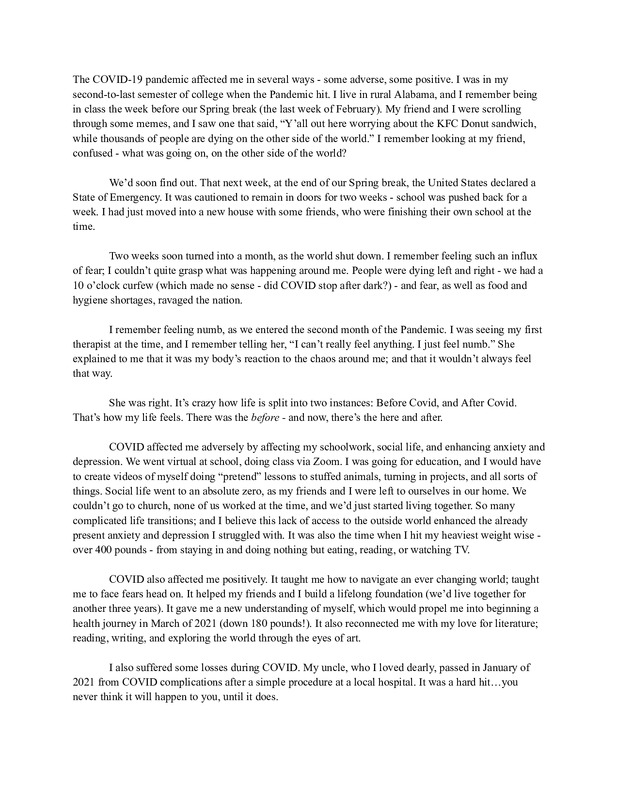 2023-07-19
2023-07-19COVID-19 Archive Story_H. Crowder
I have uploaded a personal story of how COVID-19 impacted my life; and how, in my mind, there is a before and after, two different sections of my life. I also observe the changes that were influenced by the Pandemic. -
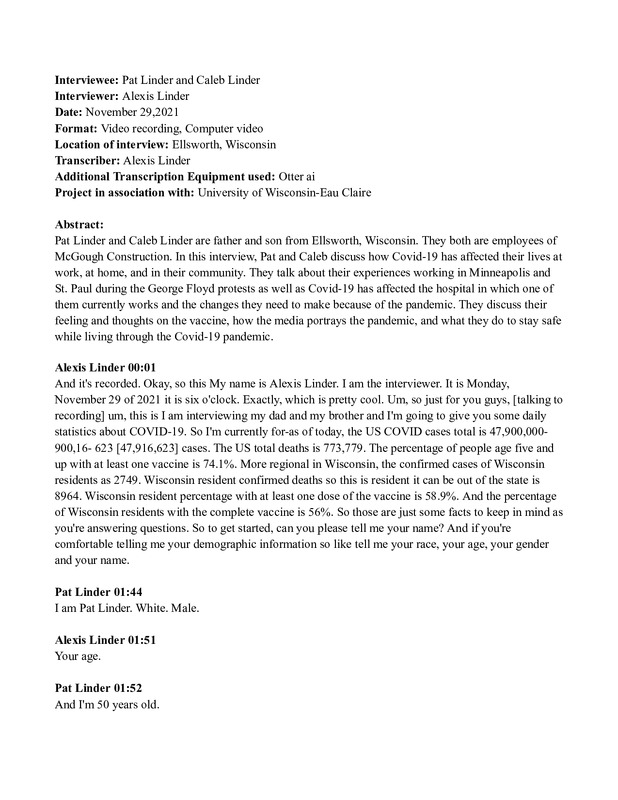 2021-11-29
2021-11-29Pat and Caleb Linder Oral History, 2021/11/29
Pat Linder and Caleb Linder are father and son from Ellsworth, Wisconsin. They both are employees of McGough Construction. In this interview, Pat and Caleb discuss how Covid-19 has affected their lives at work, at home, and in their community. They talk about their experiences working in Minneapolis and St. Paul during the George Floyd protests as well as Covid-19 has affected the hospital in which one of them currently works and the changes they need to make because of the pandemic. They discuss their feeling and thoughts on the vaccine, how the media portrays the pandemic, and what they do to stay safe while living through the Covid-19 pandemic. -
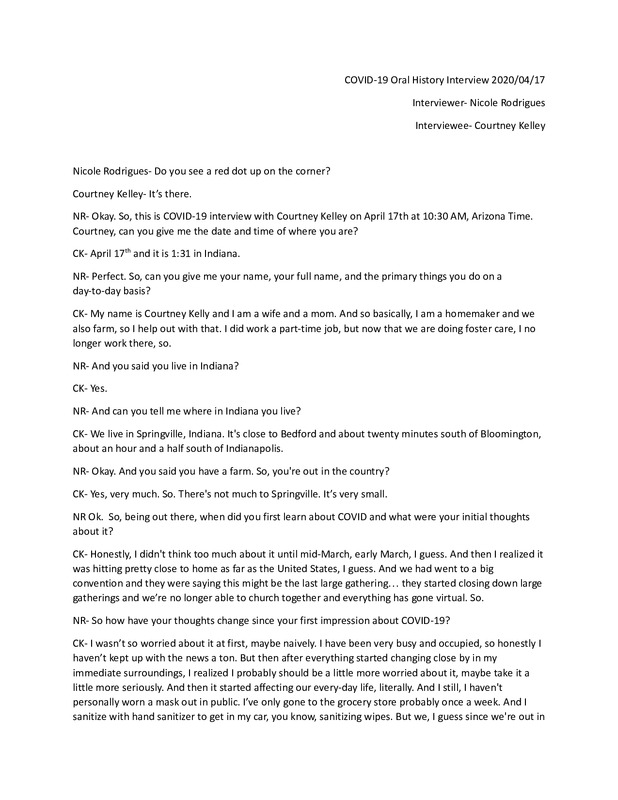 2020-04-17
2020-04-17Courtney Kelley Oral History, 2020/04/17
-
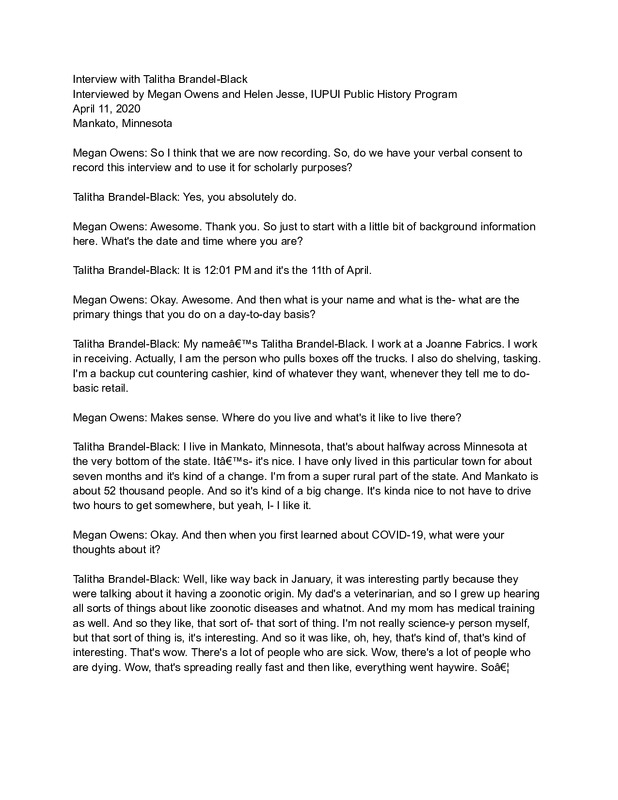 04/11/2020
04/11/2020Talitha Brandel-Black Oral History, 2020/04/11
-
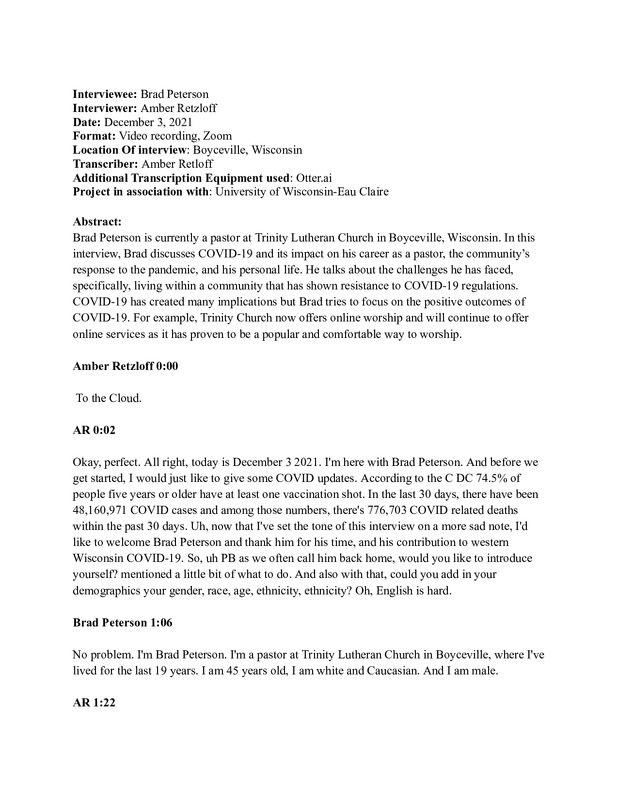 12/03/2021
12/03/2021Brad Peterson Oral History, 2021/12/03
Brad Peterson is currently a pastor at Trinity Lutheran Church in Boyceville, Wisconsin. In this interview, Brad discusses COVID-19 and its impact on his career as a pastor, the community’s response to the pandemic, and his personal life. He talks about the challenges he has faced, specifically, living within a community that has shown resistance to COVID-19 regulations. COVID-19 has created many implications but Brad tries to focus on the positive outcomes of COVID-19. For example, Trinity Church now offers online worship and will continue to offer online services as it has proven to be a popular and comfortable way to worship. -
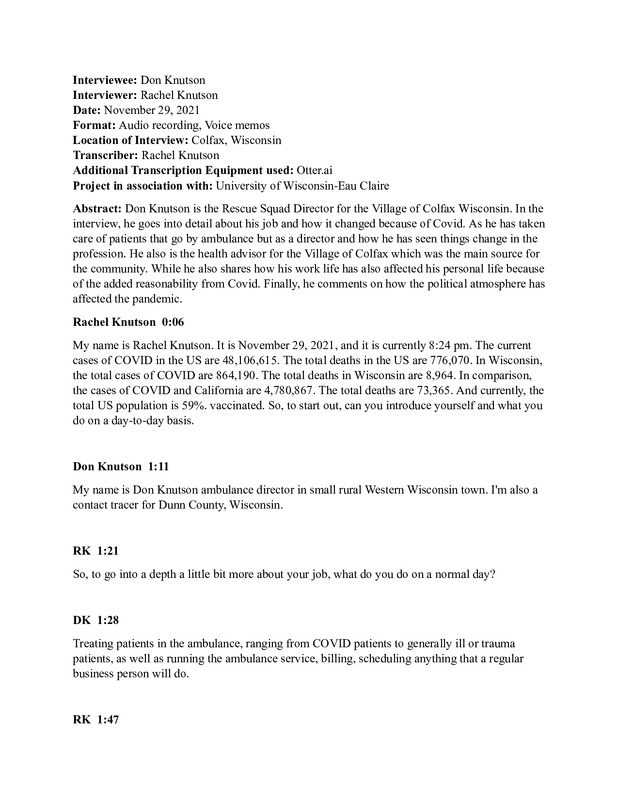 11/29/2021
11/29/2021Don Knutson Oral HIstory, 11/29/2021
Don Knutson is the Rescue Squad Director for the Village of Colfax Wisconsin. In the interview, he goes into detail about his job and how it changed because of Covid. As he has taken care of patients that go by ambulance but as a director and how he has seen things change in the profession. He also is the health advisor for the Village of Colfax which was the main source for the community. While he also shares how his work life has also affected his personal life because of the added reasonability from Covid. Finally, he comments on how the political atmosphere has affected the pandemic. -
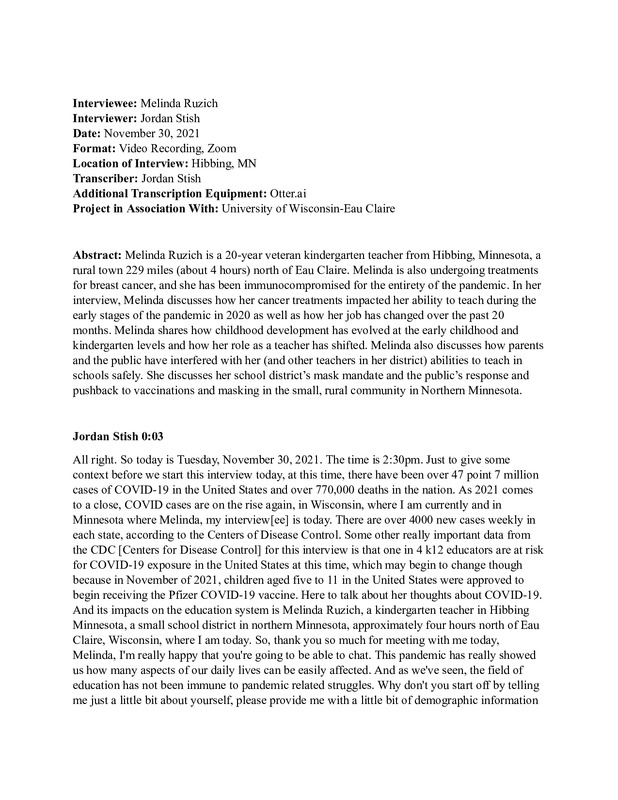 11/30/2021
11/30/2021Melinda Ruzich Oral History, 2021/11/30
Melinda Ruzich is a 20-year veteran kindergarten teacher from Hibbing, Minnesota, a rural town 229 miles (about 4 hours) north of Eau Claire. Melinda is also undergoing treatments for breast cancer, and she has been immunocompromised for the entirety of the pandemic. In her interview, Melinda discusses how her cancer treatments impacted her ability to teach during the early stages of the pandemic in 2020 as well as how her job has changed over the past 20 months. Melinda shares how childhood development has evolved at the early childhood and kindergarten levels and how her role as a teacher has shifted. Melinda also discusses how parents and the public have interfered with her (and other teachers in her district) abilities to teach in schools safely. She discusses her school district’s mask mandate and the public’s response and pushback to vaccinations and masking in the small, rural community in Northern Minnesota. -
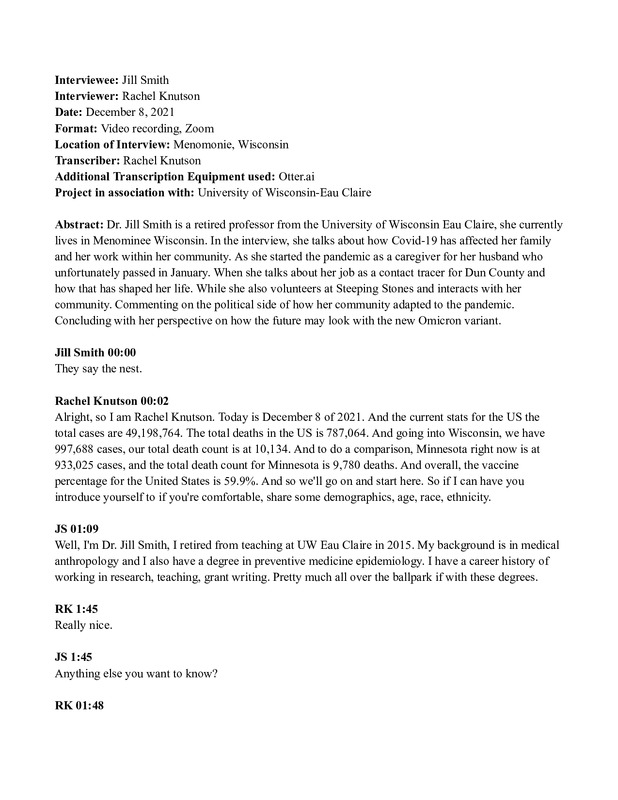 12/08/2021
12/08/2021Jill Smith Oral History, 2021/12/08
Dr. Jill Smith is a retired professor from the University of Wisconsin Eau Claire, she currently lives in Menominee Wisconsin. In the interview, she talks about how Covid-19 has affected her family and her work within her community. As she started the pandemic as a caregiver for her husband who unfortunately passed in January. When she talks about her job as a contact tracer for Dun County and how that has shaped her life. While she also volunteers at Steeping Stones and interacts with her community. Commenting on the political side of how her community adapted to the pandemic. Concluding with her perspective on how the future may look with the new Omicron variant. -
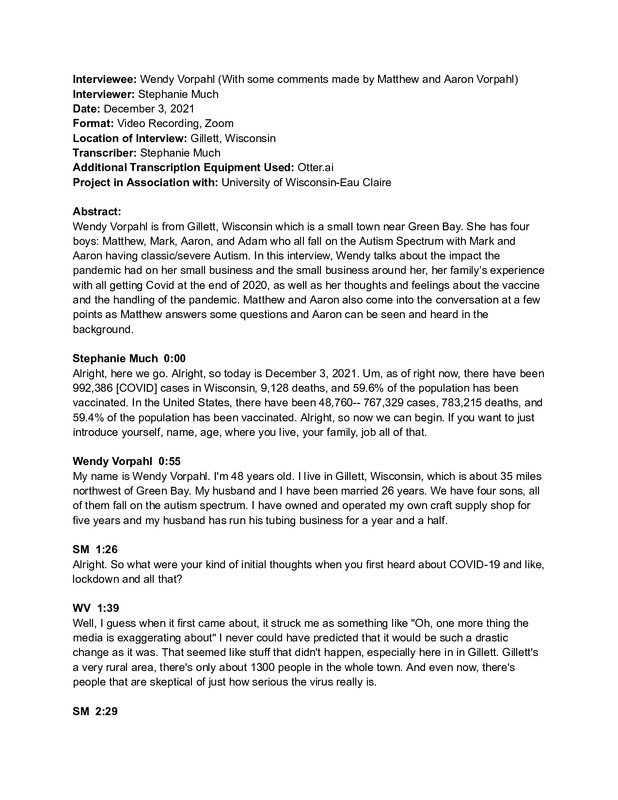 12/03/2021
12/03/2021Wendy Vorpahl Oral History, 2021/12/03
Wendy Vorpahl is from Gillett, Wisconsin which is a small town near Green Bay. She has four boys: Matthew, Mark, Aaron, and Adam who all fall on the Autism Spectrum with Mark and Aaron having classic/severe Autism. In this interview, Wendy talks about the impact the pandemic had on her small business and the small business around her, her family’s experience with all getting Covid at the end of 2020, as well as her thoughts and feelings about the vaccine and the handling of the pandemic. Matthew and Aaron also come into the conversation at a few points as Matthew answers some questions and Aaron can be seen and heard in the background. -
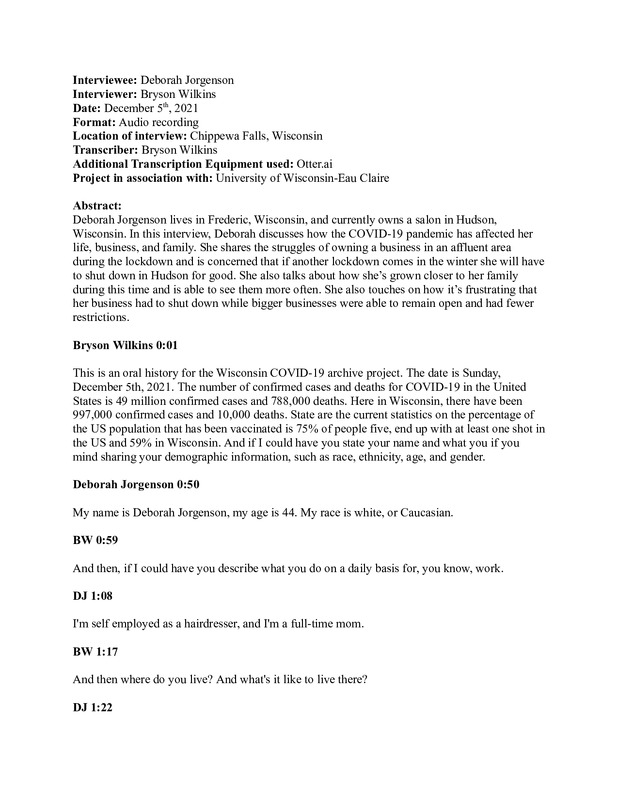 12/05/2021
12/05/2021Deborah Jorgenson Oral History, 2021/12/05
Deborah Jorgenson lives in Frederic, Wisconsin, and currently owns a salon in Hudson, Wisconsin. In this interview, Deborah discusses how the COVID-19 pandemic has affected her life, business, and family. She shares the struggles of owning a business in an affluent area during the lockdown and is concerned that if another lockdown comes in the winter she will have to shut down in Hudson for good. She also talks about how she’s grown closer to her family during this time and is able to see them more often. She also touches on how it’s frustrating that her business had to shut down while bigger businesses were able to remain open and had fewer restrictions. -
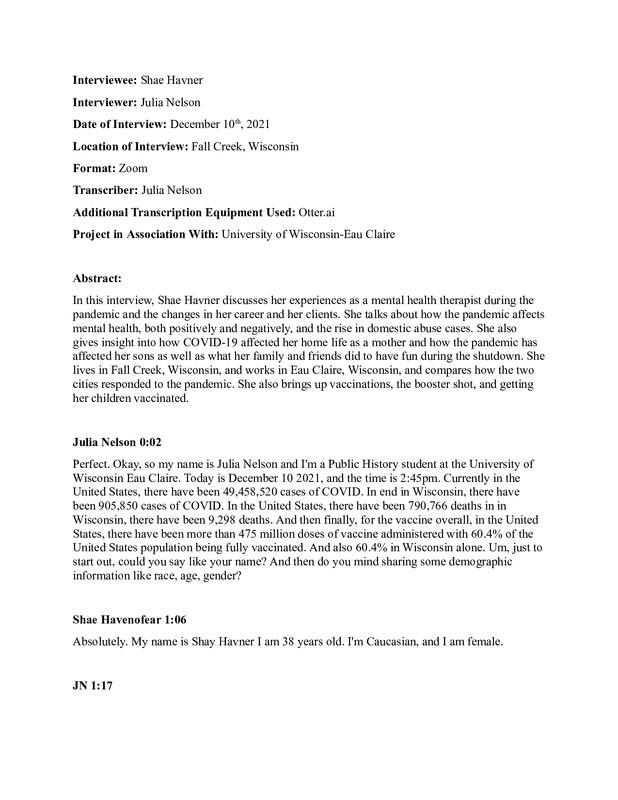 12/10/2021
12/10/2021Shae Havner Oral History, 2021/12/10
In this interview, Shae Havner discusses her experiences as a mental health therapist during the pandemic and the changes in her career and her clients. She talks about how the pandemic affects mental health, both positively and negatively, and the rise in domestic abuse cases. She also gives insight into how COVID-19 affected her home life as a mother and how the pandemic has affected her sons as well as what her family and friends did to have fun during the shutdown. She lives in Fall Creek, Wisconsin, and works in Eau Claire, Wisconsin, and compares how the two cities responded to the pandemic. She also brings up vaccinations, the booster shot, and getting her children vaccinated. -
 11/27/2021
11/27/2021Rebecca Ferber Oral HIstory, 2021/11/27
Rebecca Lynn Ferber is a resident of Oronoco, MN, and currently works for the Mayo Clinic in Rochester as a CRNA (Certified Registered Nurse Anesthetist). In this interview, Rebecca talks about how COVID has affected her job as a CRNA and Mayo Clinic as a whole as well as a mom and wife. She also talks about how it has affected her family and friends and how some of her relationships have been strained because of different views on COVID. She touches on how it not only affects people's physical health but mental health as well and gives some advice for future generations. -
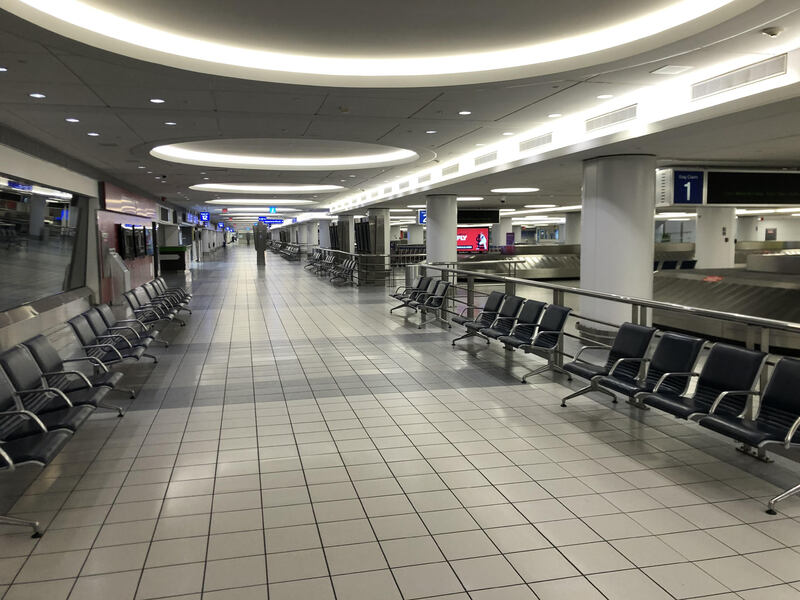 2020-05-23T09
2020-05-23T09Sampling a dystopian world
We lived in a very town in western Illinois as the pandemic arrived in America. Covid-19 seemed abstract until circumstances caused us to travel to a major international airport. The eerie quiet, in place of what should have been a noisy, madcap atmosphere, elevated sounds I normally would not have heard. It was as if a scene from a science fiction film had jumped off the screen and into my life. The experience had a nightmarish quality that has stayed with me two years later. -
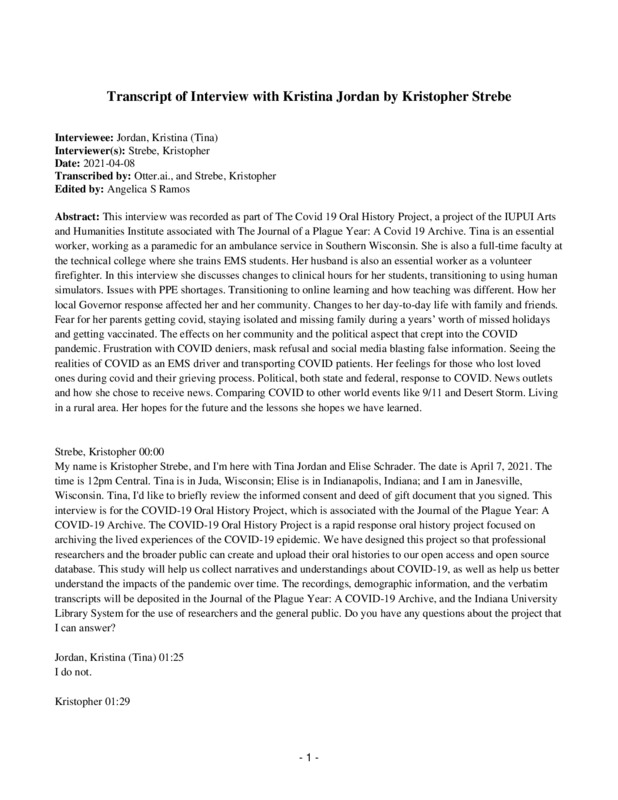 04/29/2021
04/29/2021Kristina Jordan Oral History, 2021/04/08
This interview was recorded as part of The Covid 19 Oral History Project, a project of the IUPUI Arts and Humanities Institute associated with The Journal of a Plague Year: A Covid 19 Archive. Tina is an essential worker, working as a paramedic for an ambulance service in Southern Wisconsin. She is also a full-time faculty at the technical college where she trains EMS students. Her husband is also an essential worker as a volunteer firefighter. In this interview she discusses changes to clinical hours for her students, transitioning to using human simulators. Issues with PPE shortages. Transitioning to online learning and how teaching was different. How her local Governor response affected her and her community. Changes to her day-to-day life with family and friends. Fear for her parents getting covid, staying isolated and missing family during a years’ worth of missed holidays and getting vaccinated. The effects on her community and the political aspect that crept into the COVID pandemic. Frustration with COVID deniers, mask refusal and social media blasting false information. Seeing the realities of COVID as an EMS driver and transporting COVID patients. Her feelings for those who lost loved ones during covid and their grieving process. Political, both state and federal, response to COVID. News outlets and how she chose to receive news. Comparing COVID to other world events like 9/11 and Desert Storm. Living in a rural area. Her hopes for the future and the lessons she hopes we have learned. -
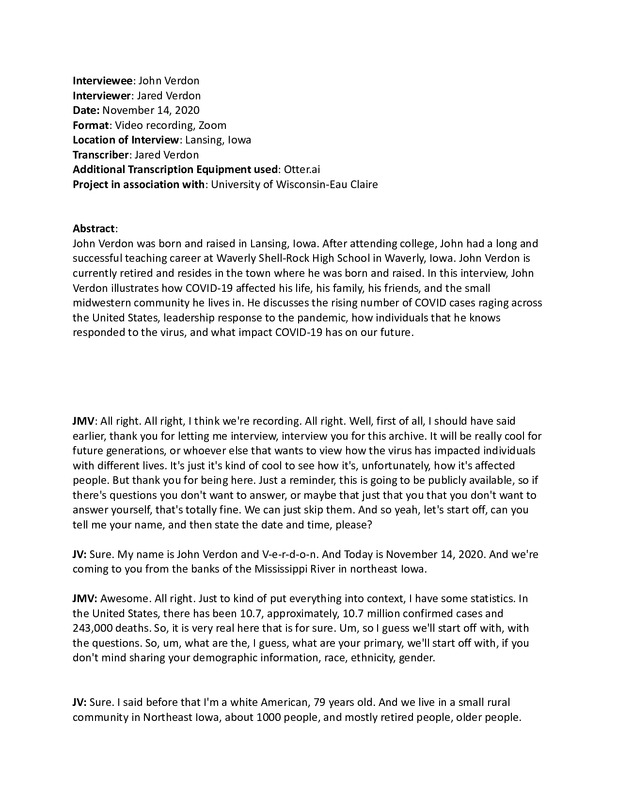 11/20/2020
11/20/2020John Verdon Oral History, 2020/11/20
John Verdon was born and raised in Lansing, Iowa. After attending college, John had a long and successful teaching career at Waverly Shell-Rock High School in Waverly, Iowa. John Verdon is currently retired and resides in the town where he was born and raised. In this interview, John Verdon illustrates how COVID-19 affected his life, his family, his friends, and the small midwestern community he lives in. He discusses the rising number of COVID cases raging across the United States, leadership response to the pandemic, how individuals that he knows responded to the virus, and what impact COVID-19 has on our future. -
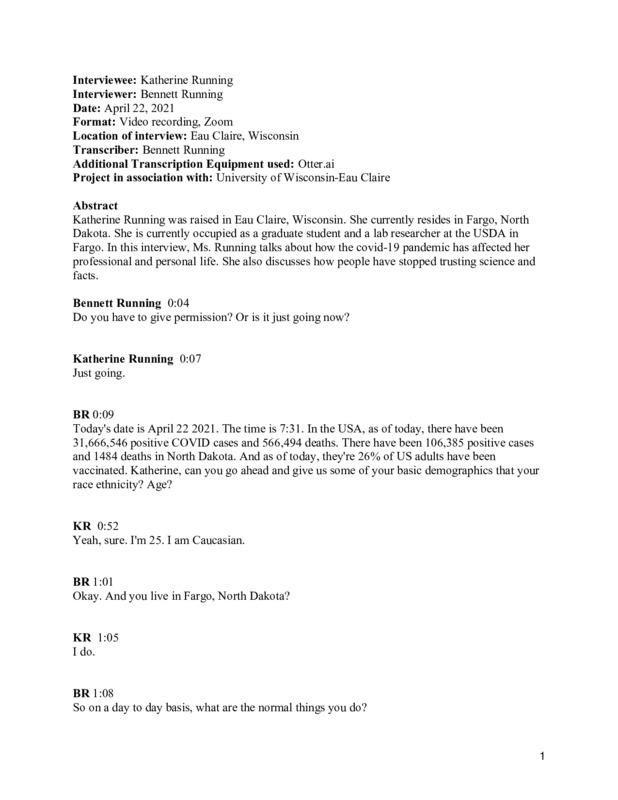 05/12/2021
05/12/2021Katherine Running Oral History, 2021/04/22
Katherine Running was raised in Eau Claire, Wisconsin. She currently resides in Fargo, North Dakota. She is currently occupied as a graduate student and a lab researcher at the USDA in Fargo. In this interview, Ms. Running talks about how the covid-19 pandemic has affected her professional and personal life. She also discusses how people have stopped trusting science and facts. -
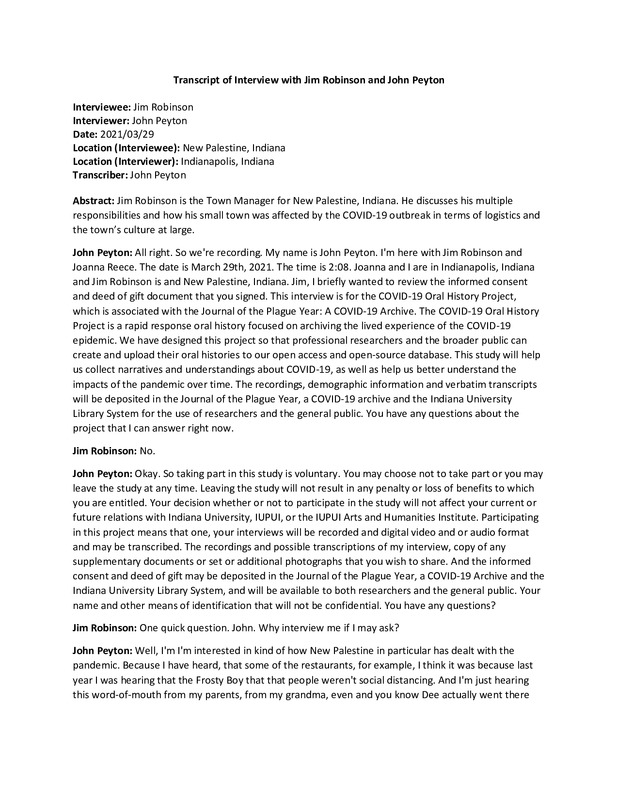 03/29/2021
03/29/2021Jim Robinson Oral History, 2021/03/29
-
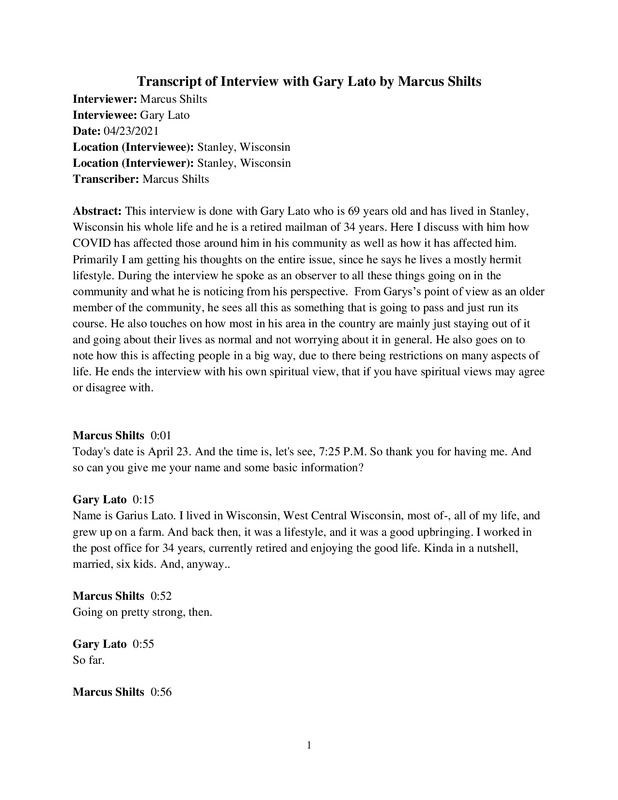 04/23/2021
04/23/2021Gary Lato Oral History, 2021/04/23
This interview is done with Gary Lato who is 69 years old and has lived in Stanley, Wisconsin his whole life he is a retired mailman of 34 years. Here I discuss with him how COVID has affected those around him in his community as well as how it has affected him. Primarily I am getting his thoughts on the entire issue since he says he lives a mostly hermit lifestyle. During the interview, he spoke as an observer of all these things going on in the community and what he is noticing from his perspective. From Garys’s point of view as an older member of the community, he sees all this as something that is going to pass and just run its course. He also touches on how most in his area in the country are mainly just staying out of it and going about their lives as normal and not worrying about it in general. He also goes on to note how this is affecting people in a big way, due to there being restrictions on many aspects of life. He ends the interview with his own spiritual view, that if you have spiritual views may agree or disagree with them. -
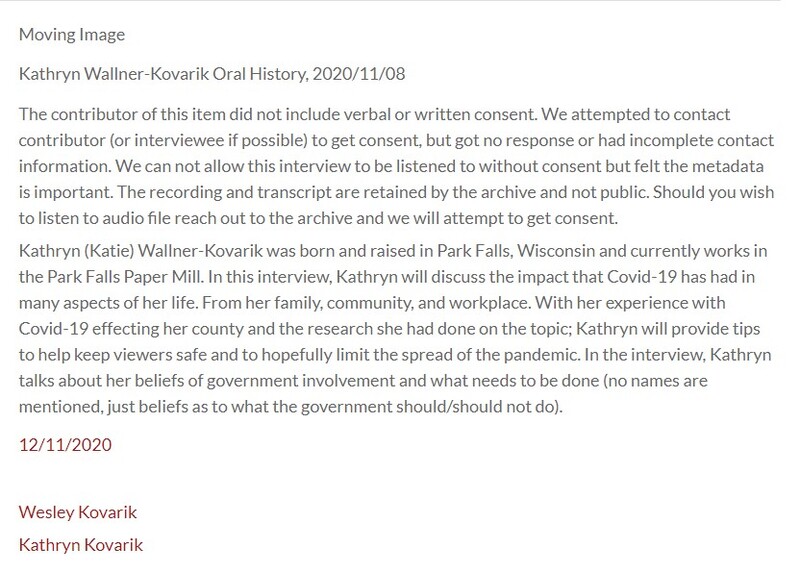 12/11/2020
12/11/2020Kathryn Wallner-Kovarik Oral History, 2020/11/08
The contributor of this item did not include verbal or written consent. We attempted to contact contributor (or interviewee if possible) to get consent, but got no response or had incomplete contact information. We can not allow this interview to be listened to without consent but felt the metadata is important. The recording and transcript are retained by the archive and not public. Should you wish to listen to audio file reach out to the archive and we will attempt to get consent. -
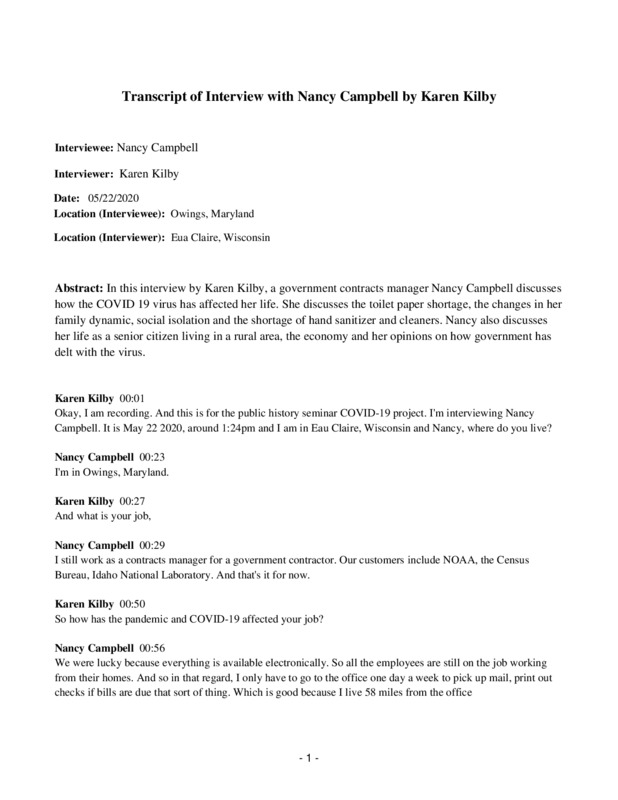 05/22/2020
05/22/2020Nancy Cambell Oral History, 2020/05/22
In this interview by Karen Kilby, a government contracts manager Nancy Campbell discusses how the COVID 19 virus has affected her life. She discusses the toilet paper shortage, the changes in her family dynamic, social isolation and the shortage of hand sanitizer and cleaners. Nancy also discusses her life as a senior citizen living in a rural area, the economy and her opinions on how government has delt with the virus. -
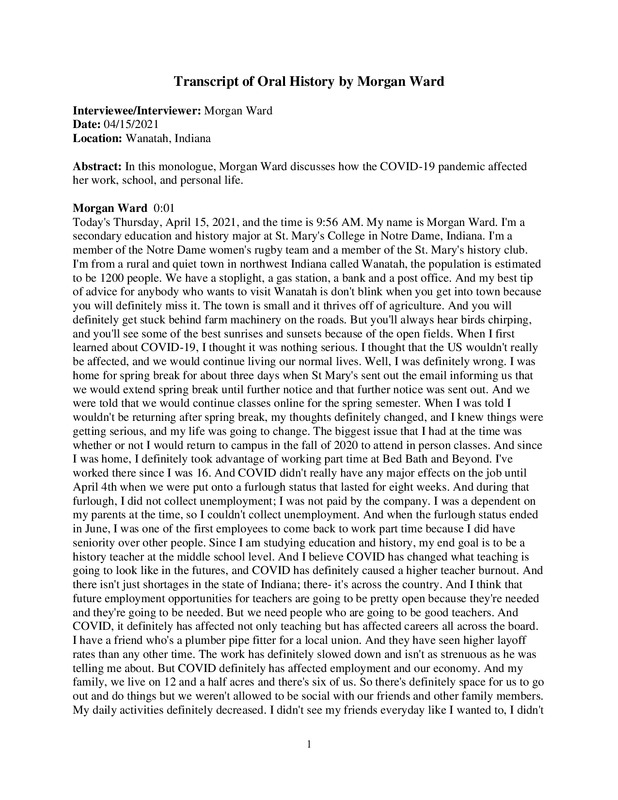 04/18/2021
04/18/2021Morgan Ward Oral History, 2021/04/18
C19OH -
2020-04-02
The Silence of Nature
I live in a rural area of southeastern Louisiana. When I first moved here the only thing that you could hear at night was the natural sounds that one would think of when being in the country, but as developments started to move into my area the air was polluted with the sound of cars on the distant interstate. The nights become a harmony of grasshoppers and traffic all mixed into a melody that formed a hybrid of urban and rural life. On the night of April 2nd, 2020 I was enjoying a night of looking at the stars through my telescope. It was a mainly clear night when I closed my eyes and began listening realized that I could no longer hear the cars on the interstate. Louisiana was in the mist of the a very high spike in COVID and lockdowns were in effect meaning there were fewer cars on the roads especially at night. I sat and listened for hours as I was able to hear all the sounds that were once masked by the intrusion of development on my rural area. From about April 2nd until early July this quite remanded at night. It was not until Louisiana started to open up more that the sound of the cars returned to my nighttime symphony. When I look back on the early days of the pandemic this is the memory that stands out and how it will be remembered by me. Though a harsh time in the world and for humanity, the sounds of technology and modernization were drowned out by nature for a time and it made the nights a little more peaceful and less stressful with all that was going on in the world. -
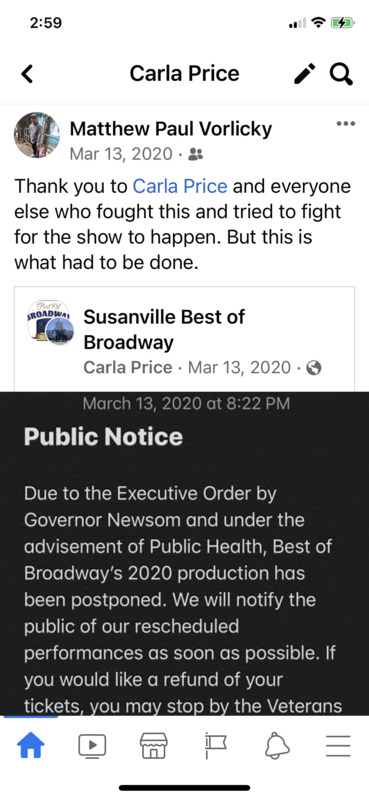 2020-03-13
2020-03-13The Fight for a Show
When the global pandemic hit, we were just a day away from putting on a theater production that we had worked on for a year and over 10 weeks of rehearsal. As a board, we thought of every possible way to keep a show, so that it wasn't shut down. I went and measured the venue, the local Veterans Hall to see how many seats we could have in the hall, if they were six-feet apart. We looked at requiring mask or limiting to just family. We met with local public health officials with different options on how to keep our show. But, the final decision was that it was in our best interest to cancel the show. The concern was that with family coming in from other areas, that Best of Broadway could be responsible for bringing Covid-19 to Susanville, and we were not willing to take that risk. When we cancelled, we figured we just needed to reschedule the show a couple of weeks. That, in and of itself was challenging. But the idea of a possible lawsuit or worse causing harm to others was a real possibility. As the Board President, I had to announce via Facebook and Instagram that the show was cancelled. It was terrible. A very sad day for our Broadway family. This post was from one of the husbands of our performers. His words of encouragement was reassuring. Most people responded in a sympathetic and understanding way. -
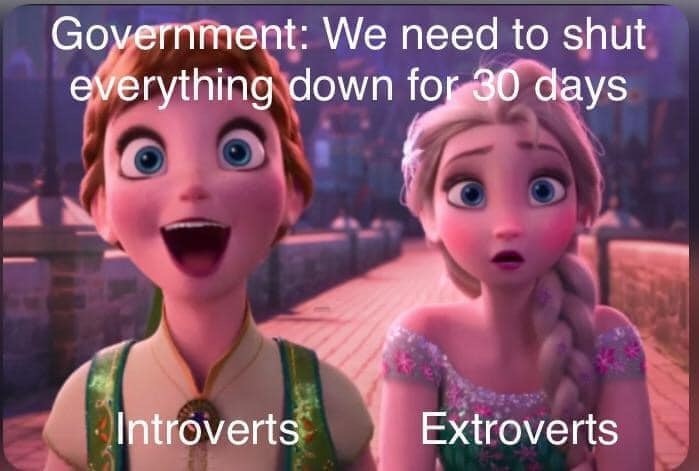 2020-03-23
2020-03-23Introverts vs. Extroverts during Lock Down-A meme
I am an extrovert. I get my energy from people. I love people. I surround myself with a lot of people. The three months leading up to the pandemic lock down I had been surrounded almost every day by almost 200 of my closest friends, people I call my family because we worked together on a theater production called Susanville Best of Broadway. When the pandemic hit, the show was cancelled and then even my work sent everyone home. I was home with my kids. And it was very quiet. We are a very active family involved in many local community projects. I have meetings every week and they have sports. All of sudden, we were home. And if I saw someone I knew while out in public (the grocery store) it was weird. I didn't know if I could hug them (I didn't) and would just awkwardly wave from a distance. It was terrible. In fact, my girls struggled and would still have friends over. I made them limit it to just one friend, but even then, we struggled. This meme really got to me. I remember hearing friends say how their life didn't change at all because they were already homebodies. The idea of being home was actually very stressful. I ended up working at my work, because being home all day to work was not very much fun. I learned a lot about myself during that time. Most importantly, I need people in my life. -
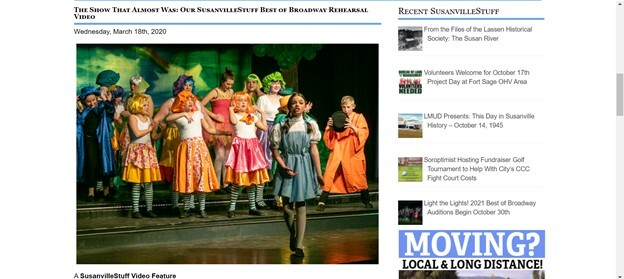 2020-03-18
2020-03-18The Show that Almost Was
After Susanville's Best of Broadway show was cancelled just a day before its opening night, Susanville's local online news editor Jeremy Couso reached out to the Best of Board members to see if he could publish an article about our show, the show that never happened. He and his wife attends the performance for a media night and he happened to have a video of the show. For a small production, the youtube video of the performance has had just under 900 views as of October 9th, 2021. I directed Wizard of Oz with a dear friend of mine, in a one year shot to direct. Watching the video of the show that didn't happen is honestly very sad and hard to do. We become family with the cast and to not reach the finale is painful. But the show must go on, and in 2022, Best of Broadway will take the stage again. -
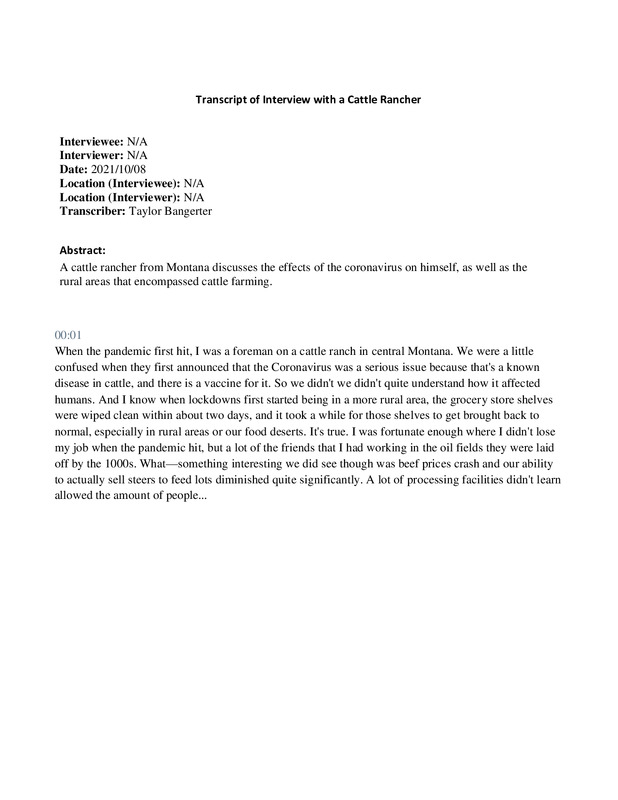 2021
2021POV of a Cattle Rancher
This is important to me because this is my partner speaking. At the beginning of the pandemic we were living in Montana on a working cattle ranch, so our experience was a lot different than what we were seeing on social media. We experienced extreme food shortages and ironically had an even harder time selling cattle to processors and feed lots. -
 2021-10-07
2021-10-07Vacation in the Pandemic
This audio recording describes a vacation my family and I took during the pandemic. A lot of the attractions were closed due to the virus, so we had to find other things to do while maintaining safety protocol (social distancing, masks). It was frustrating but we managed to still have fun. -
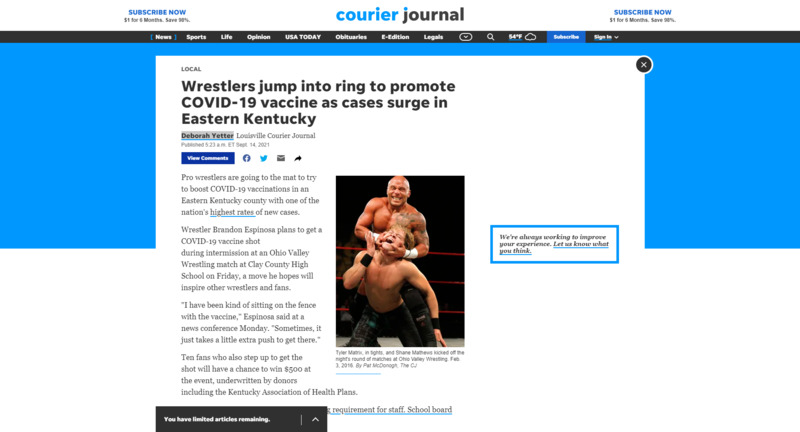 2021-10-08
2021-10-08Covid Vaccination Efforts
In the age of Covid, misinformation and disinformation runs rampant and we must meet this challenge with unconventional methods. The use of wrestling events to convince people to get vaccinated demonstrates a gendered response to the problem. What does a 'masculinized' approach say about rural and/or Appalachian culture? Is it now considered weak to comply? -
2021-09-29
Covid in Altus Oklahoma
I wanted to share my personal experience of living through the COVID-19 Pandemic in Altus Oklahoma. While my experience probably looked very similar to others, I believe it is very important to always information share so everyone can have the complete picture. I am active duty Air Force, and was residing in Altus Oklahoma during the pandemic in 2020. Living on a military base, it is not very often that you have quiet hours or down time. However, during the height of the pandemic, the majority of the base shut down and went to minimum manning for almost 30 days. It was strange to see operations halt, and all non essential workers staying home with their families for the duration of the town shut down. Organizations went from in person working to relying on home desktop computers to get the mission done. During this time people were also limited on where they were allowed to travel, and people they were allowed to see. At one point, some people were not even allowed to go on walks outside, because they were not sure how the virus would spread and if it would be safe being close to others. As doctors and scientists started discovering the make up of the virus and how to mitigate against its effects, we started gaining more liberties back. Members were no longer confined to their homes, we were able to do outdoor activities near the base, and were allowed to travel to nearby towns for any essential items. Looking back on the situation that occurred a little over a year ago, it is hard to imagine and remember what it was like to be confined to our homes and not being able to engage in social gatherings. One thing that is pandemic has highlighted to me is that despite all the adversity the world has faced, we are still determined to get the mission done efficiently and effectively everyday. I would also like to highlight the importance of social connectedness and gatherings. During the isolation period of the pandemic, the majority of people suffered from lack of communication and not being able to connect with those around them. If this pandemic has taught us anything it should be to not take your health for granted and to value the time you have with loved ones, because you never know when it will be your last time together. -
2021-09-29
Covid in Altus Oklahoma
When reflecting back on the height of the COVID-19 Pandemic in 2019, it is strange to think the whole country was isolated from other people for an upwards of three months or more. I was residing in Altus Oklahoma during the pandemic and there was a point where no one was allowed to leave their homes to even enjoy the fresh outside air. With this, a lot of local organizations were shut down for months including Churches, local eatery's, stores, and even some grocery stores. While I know my story is similar to many others, I believe that it is important to share all experiences with the community. Sharing will create a complete picture of how the pandemic shaped our society today. -
2021-09-10
A new gratitude for our little farm...
My husband and I bought a little secluded farm in Vanleer, Tennessee in 2013. We had this idyllic notion that we could grow our own food, live off the grid, and have a sense of privacy we never had living in the city. But, were were awful at it, nothing ever grew, our house was the ultimate "fixer-upper" and we were far from everything. In the last two years or so, we started to long for living in the city again, being near conveniences, and not commuting over one miles a day. Then, the pandemic came and my job sent us all home to work remotely. I am museum curator and what I do is very hands on, so that took some clever adjustment and reinvention. We also have the world's slowest internet, but I made it work by duct taping the jetpack to the only window where it worked. As the months went by, I read so many accounts of how the isolation and seclusion of shelter in place orders led to depression. Some of my friends who lived in apartments in the city described feeling claustrophobic and trapped. I realized, that despite other uncertainties caused by the pandemic, that I was happier than usual and felt completely peaceful in our little secluded twelve acre homestead. I could roam around my own land, take my dogs for walks, work on the never ending house projects, or just sit on the porch and appreciate the sunset. When things started to return to normal and we began going back into the office, I broke my foot while trail running and that added another seven months of completely remote work to my job. Physically, my recovery was grueling, but mentally I was doing well thanks to the time already spent quarantining during the pandemic. I have a new love and appreciation for this little farm that won't grow anything now. Both my husband and I have no desire to move back to the city and we have even made peace with the fact that we will never finish all the fixer-upper chores. The gratitude I feel for this beautiful place is immeasurable. I am one of the lucky people who could quarantine and not feel like I was suffering. During the pandemic, we built a small A-frame cabin down near the front of our land and offered it up as a refuge for people who needed to leave the city for a day or two. Now, it's my little yoga cabin and a place where I can sit and be thankful for my little home in the forest. -
2020-03
Rural Connecticut: Covid Doubters
I lived in a rural part of Connecticut during the 2020 Covid lockdowns. Despite the widely publicized nature of the pandemic, at least half of the citizens in my town didn't believe the disease was real. There was a real divide over wearing masks and closing down schools/work because many people felt the disease was over-blown, not deadly, or simply wouldn't strike a rural place as hard as a city. While my town didn't suffer as much as places like New York City did, we still had Covid cases and deaths across the county. It was frustrating to live in a rural place during the outbreak, because even though we were "safer," than city-dwellers, nobody took measures to preserve that safety. This mindset continued when vaccines became available, and the latest rage in rural areas is using Ivermectin (horse medicine) instead. -
2020-05
Waiting to be Connected
I moved out of New York City for a month in the spring of 2020 during the period where my gallery furloughed most employees aside from the principal directors and a select number of sales people. I spent that time with my father in upstate New York in a close quarters quarantine. I was always struck by the quiet during the day and how visible and bright the stars were at night. Two things that seemed foreign to me at times as I grew up in cities and had lived in various Brooklyn neighborhoods for the past year. The passing sound of car stereos and people’s voices on fire escapes from a floor above were white noise. All vibrant - completely alive - no stars. His apartment was a studio and at the time he had not yet begun paying for internet service. Some nights we would drive four or so minutes down the road to the apartment complex where my Dad used to live a few years prior. We would camp outside the complex’s gym which housed one or two treadmills and the outside looked like a glorified garage - but it had wifi. As we were no longer residents and owners of a key pass to the facility, my Dad would pull up to the side entrance and put on his hazards. I would jump out and begin to search for a signal and attempt to connect to the complimentary internet. Whenever a stray person would emerge from their units to retrieve Amazon packages from their front stoop, I would make uncomfortable eye contact with them, as I held up my phone. Yes, yes, this is what you think it is. They hastened back up and quickly closed their door behind them. I found that the most expedient way of downloading content was to position myself by the exterior front left corner and stand with my back flush against the wall. Every night my Dad and I listened to podcasts and drank tea. Despite everything, moments like these helped us laugh and I look back at this memory fondly. -
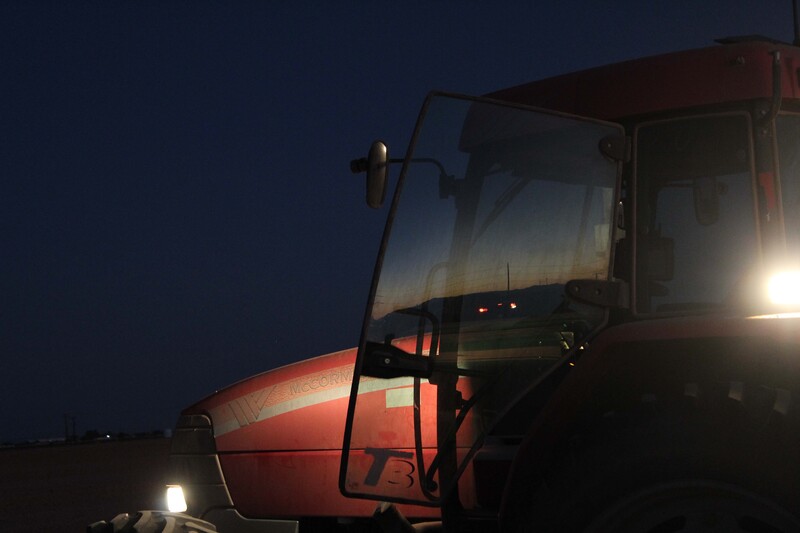 2020-10-28
2020-10-28The Minimum Wage Spotlight
The photographic story I've uploaded is about my [family member], Andres, who even with the pandemic at its worst peak, in 2020, had to continue in his job. He's an Arizona field laborer, a key worker for the farm he works in. The conditions are difficult, with a minimum wage that doesn't match the amount of work he does. As the photos indicate, his job can start at a very early time when the sun hasn't even risen. His job usually lasts 12 hours, so when it's the night shift, he doesn't come back till the morning hours. There are weeks when he has to stay inside a hot tractor for hours and there are other days when he has to do a lot of moving and carrying around. Due to the difficult weather Arizona may have, there’s a constant danger of heatstroke especially since a lot of his work includes physical labor. Looking deeper, these pictures of the work Andres does feels like a representation of the unequal power there is in the minimum wage system. Here we have a field laborer, who due to lack of education and financial resources growing up, wasn’t able to reach for higher positions that require degrees. He grew up in a poverty-stricken family and alongside being a Latino immigrant, opportunities were few and far between so in order to assure he keeps himself and his family fed and sheltered, so he’s forced to continue a job that doesn’t contain the best conditions or pay. This is only emphasized within the pandemic, minimum wage workers forced to continue working in bad conditions including the risk of getting sick because, in order to keep their head above water, they must. And yet, even with all the dangers and the long hours, their pay doesn’t reflect the job. This also connects to race, minorities most of the time stuck in these places due to the disadvantages they grew up with and continue to face. It’s the life of an individual who is input in a life in which already starts with less compared to privileged others, and then a pandemic hits which only emphasizes the disadvantages already there. Overall, the pandemic truly has put a spotlight on the many issues society already had. -
2021-08-09
THE19: Howl of a Mad (American) COVID-dodger, a Dia-Rant
A year from the perspective of an immuno-compromised, mulitple comorbidities survivor stranded in place until vaccine in a poor, rural, underserved and politically conservative Colorado ski and summer resort community over run by affluent COVID torurism. -
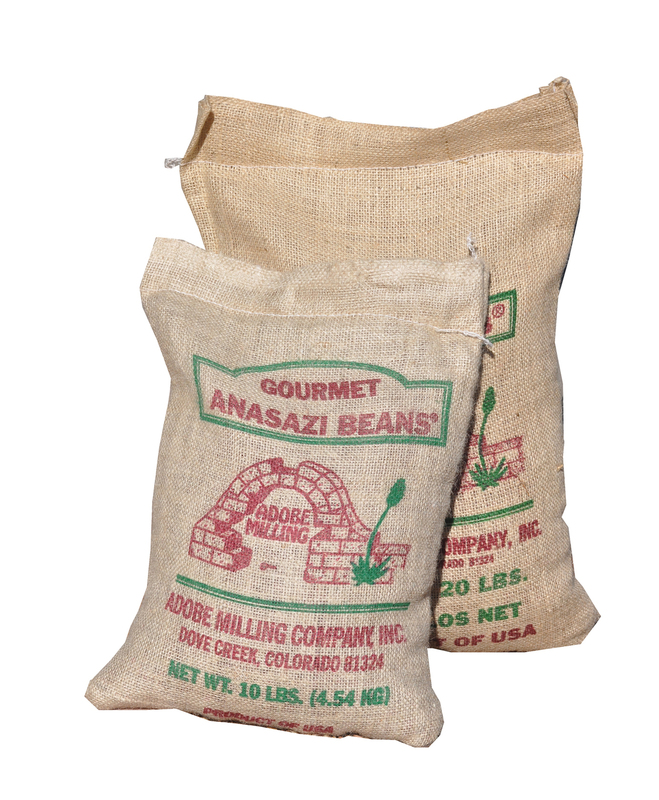 2020-05
2020-05In 2020 We Ate Certain Foods Because We Stopped Buying Fresh Produce and Meat
In late spring 2020, we begin to realize that it was too dangerous and too expensive to buy fresh produce and meat. The fresh produce was often out of stock for weeks at a time. Then other times the produce just seemed difficult to trust. The grocery store often had people without masks and the COVID numbers were rising. We really couldn't trust any fresh fruits or vegetables unless we cooked them. Eventually as the prices began to rise on fresh meats, we stopped buying those too. Eventually we found that the pandemic had completely altered our day to day eating habits. We didn't always trust restaurants for takeout since they had COVID outbreaks also. Living in a small rural town, we had limited options. This left us trying to buy a few canned foods at stores or ordering delivery of shelf-stable foods in bulk from online retailers. One of the things that I remember the most is how I began to struggle with my blood pressure. We were eating too many boxed and canned foods; not enough fruit and vegetables. My sodium intake was high and my potassium was low. We then decided we would start buying dehydrated vegetables and fruit. We tried not to buy canned versions that were preserved with salt. The main thing I remember is that one of the first meals that seemed so good and healthy was a meal of Anazazi beans. We had bought some in New Mexico the year before and really liked them. This time we bought a 10 lb bag and assumed that we may have to stock up as the pandemic continued on. We also bough dehydrated onions, dehydrated jalapenos, and other dehydrated mixed vegetables. We did an instant pot of the beans and what ingredients we had. We really enjoyed it. For the first time in weeks, it felt like a real meal. And this was a hot meal during a warm time of year, something we would normally never cook before 2020. Here is the instant pot recipe and with the ingredients we had, leaving out the ones we didn't have. We adapted as best we could. The original full recipe is linked for comparison. The recipe we found: Instant Pot Anasazi Beans Ingredients 2 cups. dried Anasazi Beans 6 cloves garlic, peeled and smashed 4 c. low sodium chicken stock 1 c. water 1 fresh bay leaf (or 2 dried) 1 t. cumin 1 t. dried oregano 1 t. dehydrated jalapenos 1/8 c. dried onion salt and pepper to taste Instructions: 1. Place dried beans, crushed garlic cloves, chicken stock, water, cumin, oregano, bay leaves, dehydrated jalapenos, and dried onion in instant pot. 2. Close lid and pressure cook at high pressure for 25 minutes, then pressure release for roughly 15 minutes. Open the lid carefully. 3. Switch pot to soup setting. Stir occasionally for about 10 minutes. Taste and season with salt and pepper. 4. Serve. http://eliotseats.com/2019/01/27/instant-pot-anasazi-beans/ -
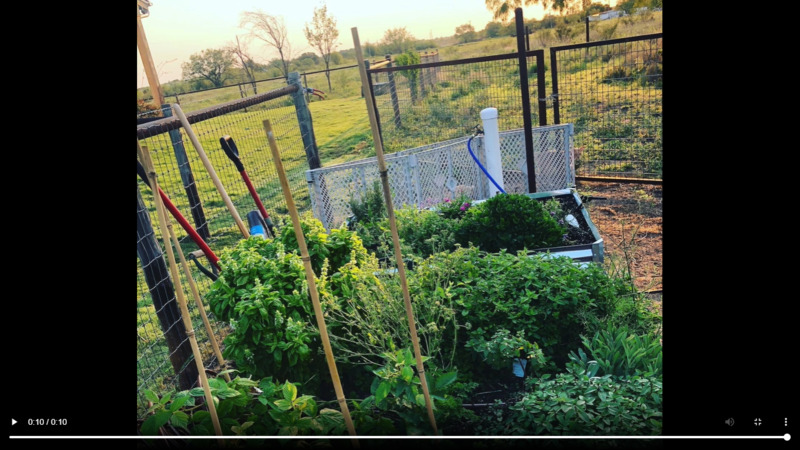 2021-08-06
2021-08-06Covid Gardening Story and Okra Recipe
I chose to focus on my garden and our chickens that we began right before the pandemic hit. I never realized how lucky I was to live in a rural environment until Spring 2020, when living in the country meant having a bit more freedom than in the city. Our garden and chickens provided us with foods that sometimes were out of stock in our small, local store. However, we also faced other things in our community that made the psychological aspects of the pandemic really hard, such as living with those who deny the reality of the disease and mitigation efforts that people like my husband promoted, as an ER physician. I suppose this story is a bit of a love letter to our little property out in the country, despite the differences in values that we have with our town. -
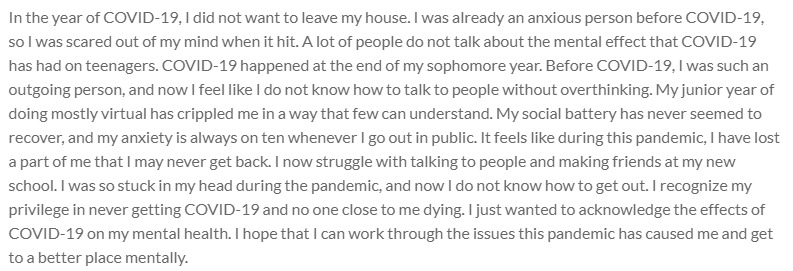 2021-07-06
2021-07-06The Year the World Turned Upside Down
In the year of COVID-19, I did not want to leave my house. I was already an anxious person before COVID-19, so I was scared out of my mind when it hit. A lot of people do not talk about the mental effect that COVID-19 has had on teenagers. COVID-19 happened at the end of my sophomore year. Before COVID-19, I was such an outgoing person, and now I feel like I do not know how to talk to people without overthinking. My junior year of doing mostly virtual has crippled me in a way that few can understand. My social battery has never seemed to recover, and my anxiety is always on ten whenever I go out in public. It feels like during this pandemic, I have lost a part of me that I may never get back. I now struggle with talking to people and making friends at my new school. I was so stuck in my head during the pandemic, and now I do not know how to get out. I recognize my privilege in never getting COVID-19 and no one close to me dying. I just wanted to acknowledge the effects of COVID-19 on my mental health. I hope that I can work through the issues this pandemic has caused me and get to a better place mentally. -
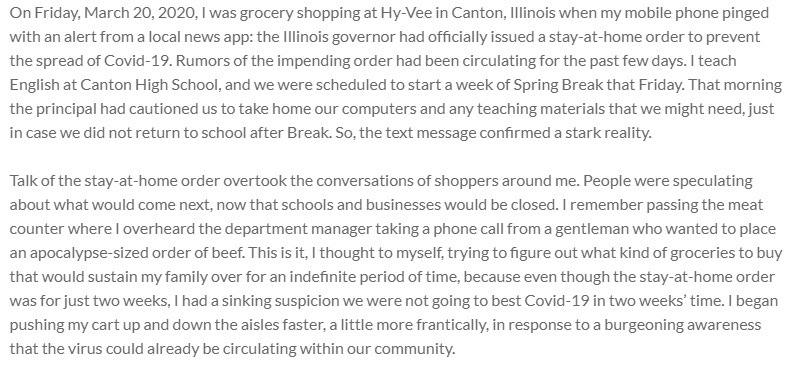 2020-03-20
2020-03-20The Signal of Approaching Silence
On Friday, March 20, 2020, I was grocery shopping at Hy-Vee in Canton, Illinois when my mobile phone pinged with an alert from a local news app: the Illinois governor had officially issued a stay-at-home order to prevent the spread of Covid-19. Rumors of the impending order had been circulating for the past few days. I teach English at Canton High School, and we were scheduled to start a week of Spring Break that Friday. That morning the principal had cautioned us to take home our computers and any teaching materials that we might need, just in case we did not return to school after Break. So, the text message confirmed a stark reality. Talk of the stay-at-home order overtook the conversations of shoppers around me. People were speculating about what would come next, now that schools and businesses would be closed. I remember passing the meat counter where I overheard the department manager taking a phone call from a gentleman who wanted to place an apocalypse-sized order of beef. This is it, I thought to myself, trying to figure out what kind of groceries to buy that would sustain my family over for an indefinite period of time, because even though the stay-at-home order was for just two weeks, I had a sinking suspicion we were not going to best Covid-19 in two weeks’ time. I began pushing my cart up and down the aisles faster, a little more frantically, in response to a burgeoning awareness that the virus could already be circulating within our community. Looking back now, I see that we were somewhat cocooned in Fulton County, Illinois, a mostly rural county. The health department announced the first positive case on April 10; the first death occurred on October 21. The virus was slow to take a foothold, but eventually it did. In late July, our school district’s board unanimously voted to start the school year fully remote. Each school day, teachers reported to ghost-town school buildings and holed up in their empty classrooms, with admonitions from administrators not to co-mingle with each other. During that time, I dutifully logged onto Google Meets for each class period, where various avatars greeted me because students were not required to turn on their cameras, so none did. Sometimes I got to hear tinny student voices, which sounded a lot further away than across town, and I wondered if each voice matched the person I pictured in my mind’s eye. I had never met the majority of my students in person, and the photographs on our school’s student management system had not been updated since the fall of 2019. I remember the frustration I struggled to keep capped when I would call on students and be met with silence. Were they even sitting by the computer? Were they afraid to say something in front of their classmates, lest they look stupid? Were they just willfully ignoring me? Were they okay, physically and mentally? I pulled more words out of students through written assignments and chat boxes than through Google Meets. Although part of the student body returned to in-person school in January of 2021 while the rest remained remote by choice (we taught both groups concurrently), it was still difficult to get students to speak, even to each other. Sadly, many of our students had become so accustomed to the idea of school as a radio broadcast—one from which they could easily disengage if they so wished—that they no longer felt it necessary to contribute their voices. In Illinois, we’ve been told that all students will return to in-person learning in the fall of 2021, with few exceptions, but I fear the virus has done irrevocable damage to our students’ speech. -
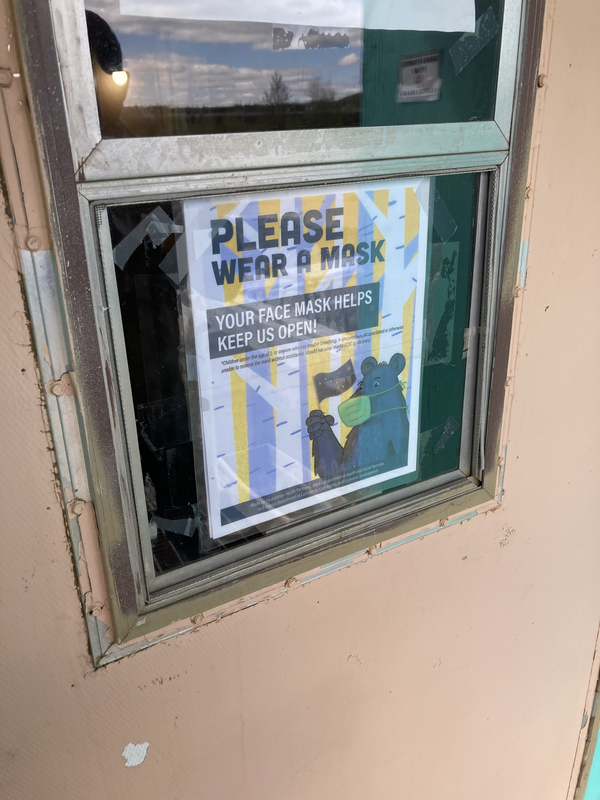 2021-05-28
2021-05-28Alaska face mask sign in rural arctic camp
Cute face mask sign on front of arctic store on the Yukon river in Alaska. -
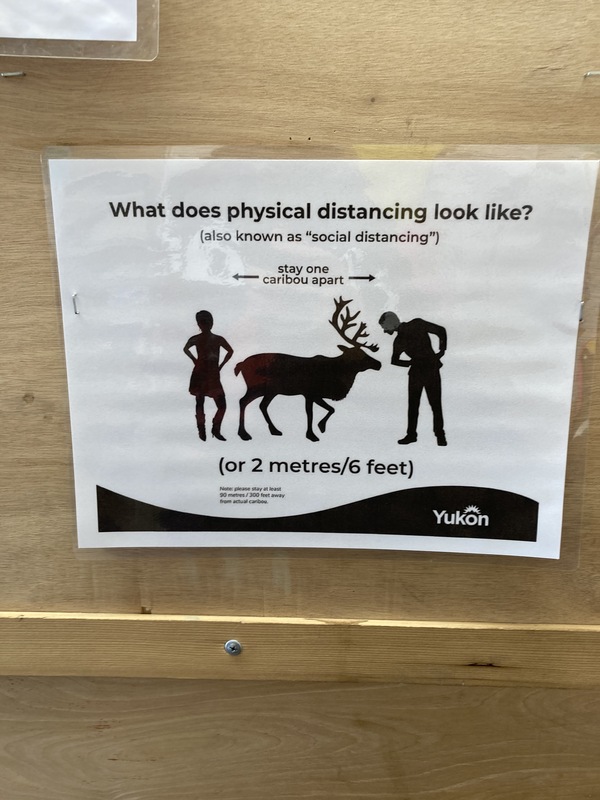 2021-05-28
2021-05-28Yukon Social distancing graphic
Found in entrance of remote camp on the Yukon river in Alaska. -
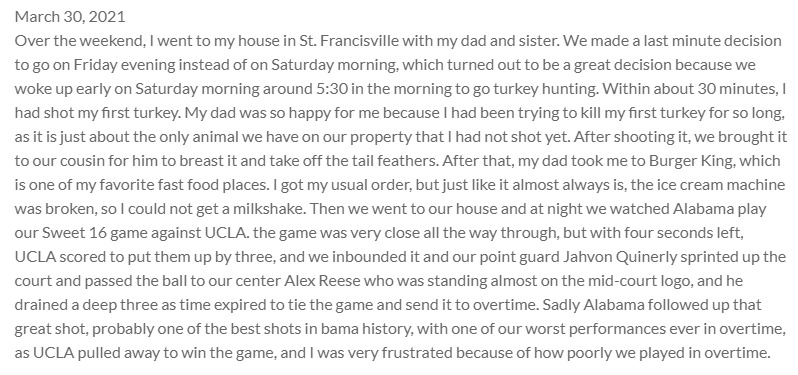 2021-03-30
2021-03-30Weekend
March 30, 2021 Over the weekend, I went to my house in St. Francisville with my dad and sister. We made a last minute decision to go on Friday evening instead of on Saturday morning, which turned out to be a great decision because we woke up early on Saturday morning around 5:30 in the morning to go turkey hunting. Within about 30 minutes, I had shot my first turkey. My dad was so happy for me because I had been trying to kill my first turkey for so long, as it is just about the only animal we have on our property that I had not shot yet. After shooting it, we brought it to our cousin for him to breast it and take off the tail feathers. After that, my dad took me to Burger King, which is one of my favorite fast food places. I got my usual order, but just like it almost always is, the ice cream machine was broken, so I could not get a milkshake. Then we went to our house and at night we watched Alabama play our Sweet 16 game against UCLA. the game was very close all the way through, but with four seconds left, UCLA scored to put them up by three, and we inbounded it and our point guard Jahvon Quinerly sprinted up the court and passed the ball to our center Alex Reese who was standing almost on the mid-court logo, and he drained a deep three as time expired to tie the game and send it to overtime. Sadly Alabama followed up that great shot, probably one of the best shots in bama history, with one of our worst performances ever in overtime, as UCLA pulled away to win the game, and I was very frustrated because of how poorly we played in overtime. -
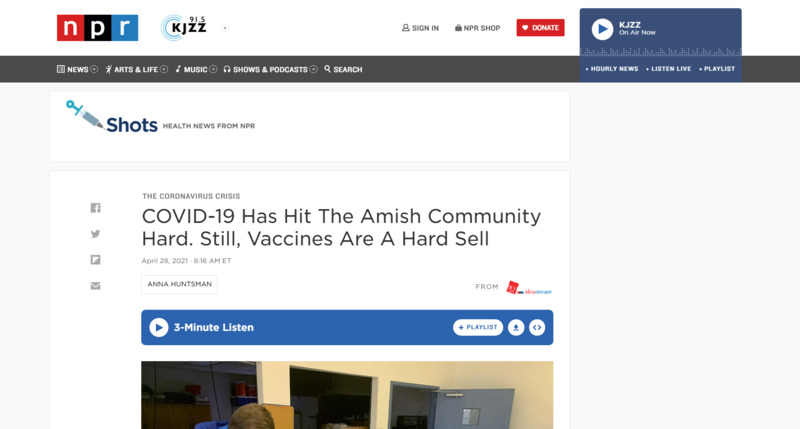 2021-04-28
2021-04-28COVID-19 Has Hit The Amish Community Hard. Still, Vaccines Are A Hard Sell
Officials are having a hard time convincing Amish populations to get the COVID-19 vaccine. This has been attributed to cultural differences and it's believed they'll start getting the vaccine once it's been around for some time. In the meantime, there are fears that the communities will have more COVID-19 outbreaks. -
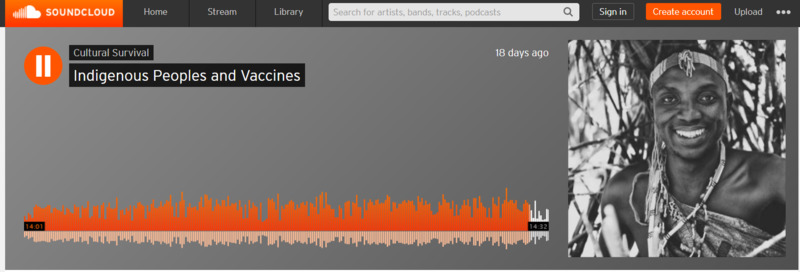 2021-04-07
2021-04-07Indigenous Peoples and Vaccines
“The coronavirus (COVID-19) pandemic poses a grave health threat to Indigenous peoples around the world. Indigenous communities already experience poor access to healthcare, significantly higher rates of communicable and non-communicable diseases, lack of access to essential services, sanitation, and other key preventive measures, such as clean water, soap, disinfectant, etc.” -
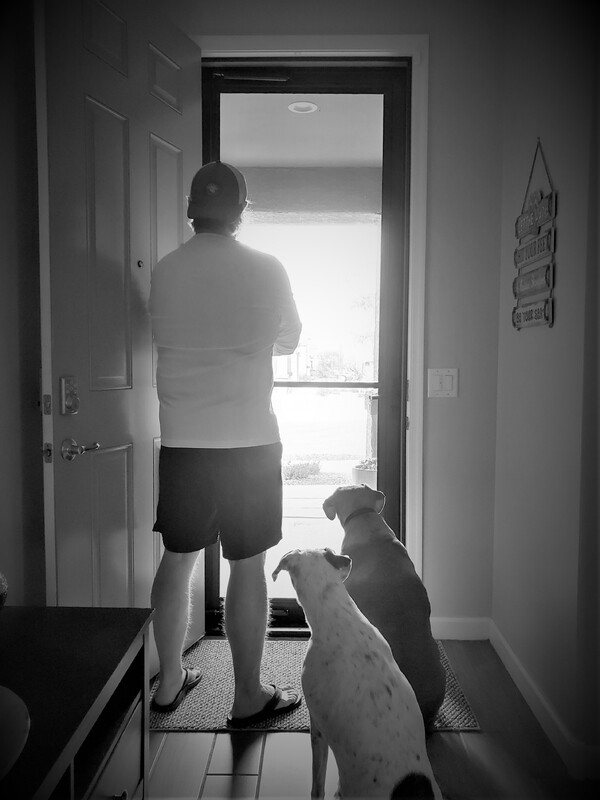 2021-04-21
2021-04-21James Rayroux's JOTPY Portfolio
--Reflections on the Pandemic Archive-- Looking back over my experience with the “Journal of the Plague Year” COVID-19 archive, my prevailing emotion is gratitude. This opportunity granted me experience that few historians earn, and the remote, asynchronous work schedule allowed me to collaborate with my colleagues in ways that maximized our respective contributions. The breadth and depth of our individual experiences and perspectives tremendously improved our collective process and products. I spent enough time in the Arizona State Archives last year to recognize such collections as historical treasure chests, but I have now participated in processing an archive’s content and navigating the ethical dilemmas those submissions sometimes create. Archivists and curators are the history profession’s truly unsung heroes, and their work facilitates society’s perception of itself. My background in police work and public safety drew me to the archive’s existing Law Enforcement collection. In taking on that subset, I succeeded in reshaping the collection’s parameters to now include stories about police and law enforcement. I wanted to diversify the collection to encompass perspective of both the police and the public with whom they interact and serve. While some overlap exists between the Law Enforcement and Social Justice collections, each remains distinct. Through my contacts and writing, I promoted a Call for Submissions to an international audience of law enforcement professionals to reduce their relative silence within the archive. Within the archive’s content, I recognized that one’s location might shape their pandemic experience, and I created and designed an Arizona-based exhibit to explore that. Further research and discussion with my mentors and colleagues ensured the exhibit illustrated these differences without excluding visitors whose diverse experiences could further enrich the archived and exhibited content. I am proud of my “Arizona’s COVID-19 Pandemics” exhibit, particularly because of its compressed, one-month incubation period. Beyond displaying images, data, and stories representative of the diverse pandemic experiences within the state, the ACP exhibit offers visitors numerous levels of interaction and engagement to became active participants and create their own exhibit experience. Visitors can complete opinion surveys, add a story to the archive, explore additional content related to the displayed pieces, view ever-changing results from pre-defined archival content searches, conduct their own archival search, view collective visitor survey results, and apply to join the staff. The exhibit’s searches will include the archive’s future submissions, which reshapes both the exhibit and the experience visitors may have with it. A more detailed explanation of my ACP exhibit may be reviewed here: https://covid-19archive.org/s/archive/item/43037 Because of Dr. Kathleen Kole de Peralta and Dr. Mark Tebeau, I stand prepared to join research, curation, and exhibition teams and immediately contribute to their work products. Despite my gratitude for this experience and the opportunities it presented, I look forward to the day COVID-19 is no longer part of humanity’s daily vernacular. James Rayroux 22 April 2021 -
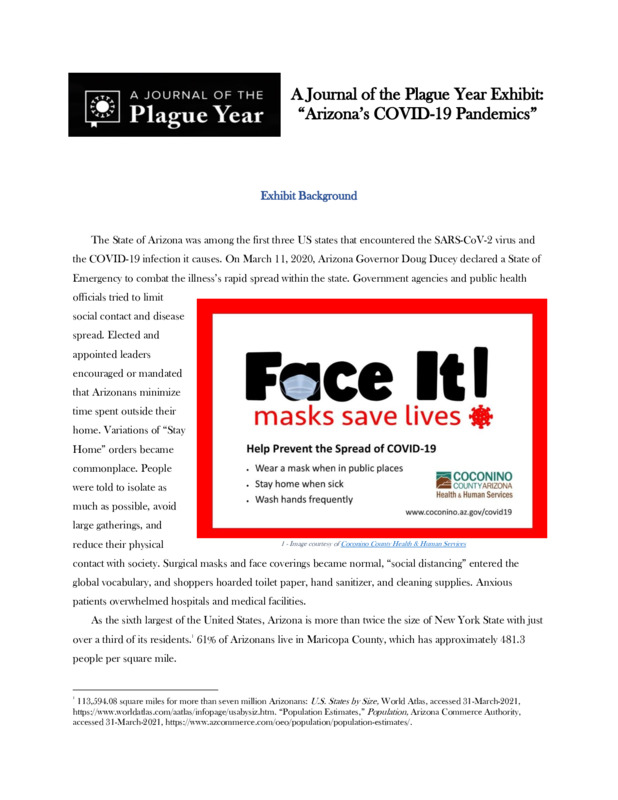 2021-04-20
2021-04-20JOTPY Exhibit: "Arizona's COVID-19 Pandemics" by James Rayroux
While working as a curatorial intern on ASU's 'A Journal of the Plague Year' COVID-19 archive, I created this exhibit on the pandemic experience within the state. In addition to obvious, overarching realities such as socioeconomic status and immediate access to healthcare systems, I initially believed one of the greatest deciding factors that determined one's experience in Arizona was an individual's residence in either predominantly urban or rural environments. The proposed exhibit had been originally titled "A Tale of Two Arizonas" to pay respect to Charles Dickens and the differing realities experienced here. To test my proposed hypothesis, I went about finding data, stories, and submissions that substantiated or disputed my premise. Within a short time, I had identified four distinct environmental drivers of personal pandemic experiences; to me, that indicated the existence of many more I hadn't yet found or had overlooked along the way. My evidence suggested a minimum of four pandemic locales: Urban, Rural, Border, and Tribal within the State of Arizona and its fifteen counties. The recorded health data and personal experiences demonstrated the naivete of my initial hypothesis, and I retitled the exhibit: "Arizona's COVID-19 Pandemics." The Exhibit Background section illustrates the vast dichotomies within Arizona in terms of population density and access to healthcare facilities. Given the virus's respiratory nature, these factors seemed especially relevant to driving diverse local experiences. I chose to include a flyer from the Coconino County Health and Human Services' "Face It! Masks Save Lives" campaign. The flyer included a specific line to "Stay Home When Sick" that seemed to illustrate a different public health paradigm than the broader "stay home" orders from Maricopa and Pima county. This section also features an image of Sedona's red rocks and a portion of The Wave to remind visitors of the wide-open rural areas accessible to all, as well as those with cultural significance to the Native American tribes and limited access to the general public. The next section asks a short, five-question survey in which visitors may participate. The Silver Linings piece features a short audio clip of a father and husband discussing some unexpected benefits of the pandemic. Visitors may explore additional Silver Linings stories and submit their own experience. The Tséhootsooí Medical Center piece seeks to illustrate the different pandemic experience on the state's tribal lands. I hoped to inspire some relevant emotional turmoil for the visitors through the piece's visual presentation. I wanted to create a series of waves with quotes from the medical center's healthcare workers. I hoped visitors' attention would be drawn to the large, bolded key words, and that they would first experience the segments out of sequence because of that. After potentially feeling a sense of chaos, they might settle themselves into a deliberate reading of the texts and find their own order within the experiences provided here. This piece allows further exploration of Native submissions and topics, a review of an additional related news article, and a submission prompt that invites visitors to offer guidance to hospital managers. The next piece illustrates the differences between mask mandates in communities across Arizona. In addition to hearing an audio clip of interviews with mayors and a public health official, visitors can explore additional submissions related to mask mandates and submit their thoughts on statewide mandates. The Arizona Department of Health Services provides zip-code specific infection data on its website, and the wide array of known case infections therein further illustrates potential dichotomies across the state. In working to include and represent this data in a consumable way, I encountered inconsistencies with tribal data. The nation's Indian tribes are overseen by Indian Health Services, a federal public health agency, and it does not collect or report data in the same manner as the State of Arizona or its counties. At first glance, the data would seem to suggest that tribal areas had less severe pandemic experiences than the rural and urban areas, which was not objectively true. I wanted to offer the unedited data to visitors, allow them to drawn their own conclusions, and invite them to offer their thoughts on what potential misunderstandings might emanate from these reporting differences. Visitors may also choose to review the foundational data from this piece, as well. I used the following two sections to offer submission prompts about the visitor's overall pandemic experience as a function of their location, as well as what they might have done if placed in charge of their city, county, or state during this pandemic. A diverse Search section allows visitors to explore additional topics of interest to them. 23 hyperlinks offer pre-defined search parameters. An Advanced Search link allows self-defined research, and a Join The Staff link connects visitors with opportunities to work within the JOTPY archive. A final section asks visitors to provide feedback on the exhibit, its content, and the pandemic in general. Both surveys within the exhibit will display overall results to visitors who participate in them. Through this process, I found incredible amounts and diversity of data outside the archive that spoke to these generally localized experiences, but not that much yet within the archive explained what Arizonans had experienced outside the state's urban environments. I created a call for submissions and delivered it to fifty rural entities that might help support the effort to collect and preserve more rural Arizona stories. Between all the local libraries, historical societies, museums, small-town mayors, and county health officials to whom I asked for help, I am optimistic the archive will better represent all Arizonans in the coming months and years. Despite the exhibit having been created, I ensured its internal search features would include future submissions and allow the exhibit to remain relevant long after its release. -
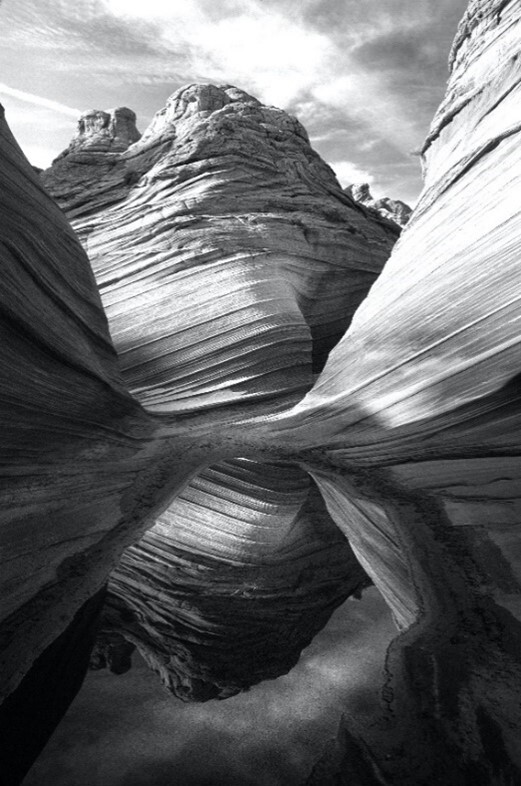 2021-04-20
2021-04-20Images and Audio from "Arizona's COVID-19 Pandemics" Exhibit
During March and April 2021, I created an online exhibit from content within Arizona State University's "A Journal of the Plague Year" COVID-19 archive. Entitled "Arizona's COVID-19 Pandemics," the digital exhibit contained images previously submitted to the archive, along with several copyright-free images I found on pexels.com. I have attached all these images. Listed by their order of appearance within the exhibit, their sources are as follows: 1- "Face It" Campaign flyer: Coconino County Health & Human Services ( https://covid-19archive.org/s/archive/item/42998 ) 2- Red Rocks, Sedona: Courtesy of Gregory Whitcoe via Pexels.com 3- Online Learning: Courtesy of August de Richelieu via Pexels.com 4- Tséhootsooí Medical Center staff: Courtesy of FDIHB Marketing Department and Navajo Times newspaper ( https://covid-19archive.org/s/archive/item/41189 ) 5- Arizona's Mask Mandate Map: created by Sarandon Raboin ( https://covid-19archive.org/s/archive/item/26267 ) 6- Arizona COVID-19 Infection Zip Code Map: Courtesy of Arizona Department of Health Services ( https://covid-19archive.org/s/archive/item/42035 ) 7- Woman Shopping: Courtesy of Anna Shvets via Pexels.com 8- Woman on Rural Arizona Road: Courtesy of Taryn Elliot via Pexels.com 9- Masked Woman in Crowd: Courtesy of Redrecords via Pexels.com 10- The Wave: Courtesy of Flickr via Pexels.com (this image is found only in the PDF submission of the exhibit, not in the public-facing exhibit itself due to document formatting technicalities - the PDF version can be found at https://covid-19archive.org/s/archive/item/42998 ) -
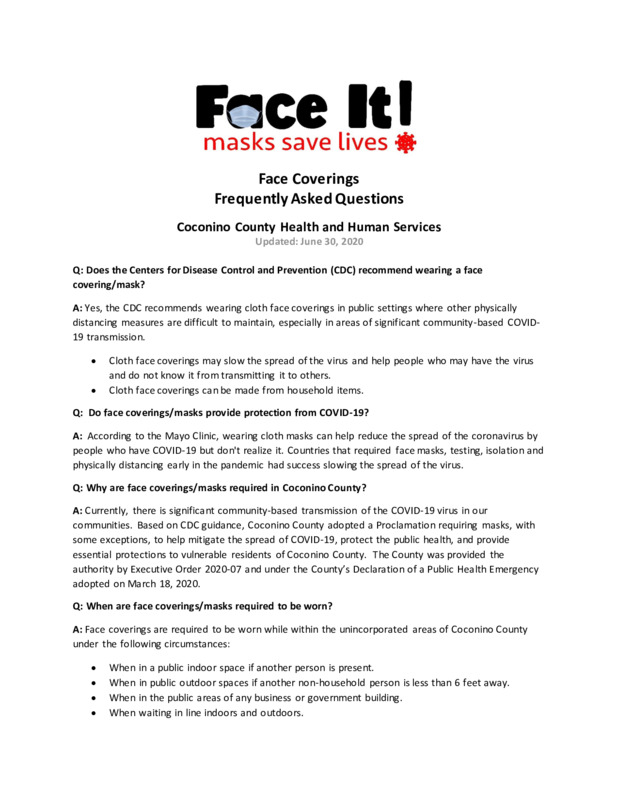 2021-04-20
2021-04-20Northern Arizona's Coconino County "Face It" Mask Campaign and Online Toolbox
The Coconino County Health & Human Services department created its "Face It" campaign in 2020 to promote the use of masks and face coverings in their communities. The following webpage is for the campaign's digital "toolbox" to give the public access to official signage for display to customers, the public, and employees to address mask use issues. -
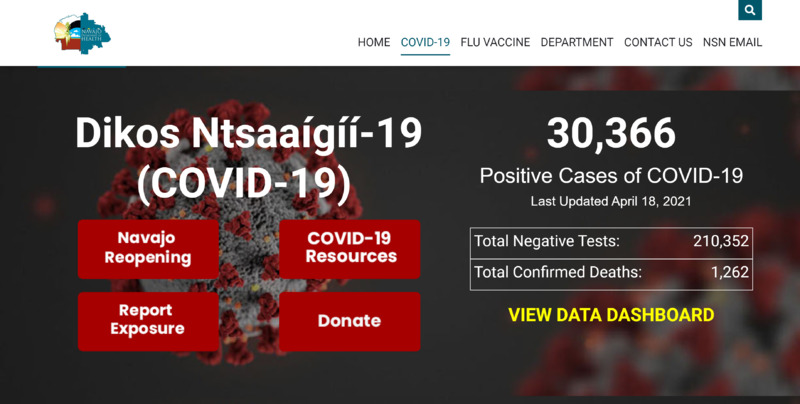 2021-04-19
2021-04-19Navajo Department of Health Data & Website
Despite recent data and statistical successes, the NDOH has left its 10pm to 5am curfew in place. The site offers a dashboard with current COVID-19 information, in terms of both resources and data. -
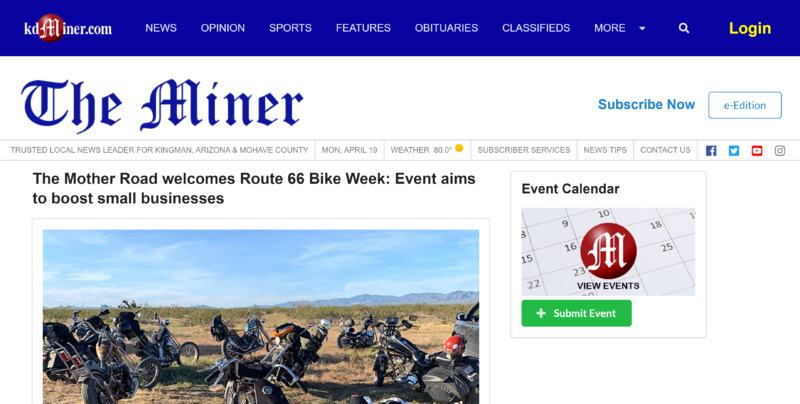 2021-04-15
2021-04-15News Article: The Mother Road welcomes Route 66 Bike Week: Event aims to boost small businesses
By Travis Rains, Kingman Daily Miner, 15 April 2021 Communities and businesses along and near the Mother Road wanted in on the action that is Route 66 Bike Week – five days of activities, games, discounts, scenic biking and more set for April 21-25 along the historic highway from Needles, California to Seligman. Event organizer Rob Borden is no stranger to motorcycle rallies as the owner of Saddle Sore Ranch, located between mile markers 36 and 37 on Route 66, approximately 17 miles from Kingman. But this is the first year for Route 66 Bike Week, which has seen the expansion of what has been dubbed the “Laughlin Loop.” “It kind of started by accident,” Borden said, noting the loop includes Route 66, going through Oatman and down over highways 95 and 68. “It’s just a nice, scenic ride for motorcycle enthusiasts. With the Laughlin River Run not happening, at least not in the past two years, I got a call from Needles, California from their tourism center asking if they could be included in this Laughlin Loop and I said ‘absolutely.’” Borden then received a call from the chamber of commerce in Oatman seeking to be included in the event. Then the City of Kingman and its visitor’s center wanted on board, followed by Seligman. “So then I’m looking at it and I’m like ‘wow, Needles to Seligman,’” Borden said. “I said ‘why don’t I just do a Route 66 Bike Week,’ and that’s how it happened. That way we can promote all these small businesses down Route 66 that even in normal times they struggle. Now with COVID, of course, they’ve been struggling even more.” So Borden began reaching out to businesses along Route 66 to see if they would be interested in participating by way of deals and discounts for event participants. “They loved the idea and wanted to be a part of it,” he said. “Basically, the idea is rather than just have a stationary event that’s confined to some big parking lot, let’s kind of highlight these businesses up and down Route 66 and get them involved. They’ve put together special offers and discounts, maybe extra effort for bands for bars. Those are different stops on the rally.” Registration for bike week can be completed by going to http://route66bikeweek.com/, with prices ranging from $45 to $48 depending on the package chosen. Borden said there is associated costs for the event that include T-shirts, bike week wristbands and dissemination of the Route 66 Passport, the latter two providing participants with access to discounts from businesses and drawings for prizes, respectively. “So when you show up with your bike week wristband, you’ll get freebies and discounts,” Borden explained. “We’ve got about 20 free drawing stops.” A scavenger hunt is planned as well utilizing the Route 66 Passport. Borden said there will be five different stops along Route 66 at which participants can have their passports stamped. Upon getting all the stamps and presenting them at Rally Central, which is Saddle Sore Ranch, they will receive a free ticket for yet another drawing. Borden also said those wishing to cruise Route 66 during bike week don’t have to register, but that they will not receive access to discounts and more. “The intent there is obviously to bring exposure to Route 66 and all these businesses, and make a big financial impact right here to the area as opposed to some of the big corporate vendors that would come into big motorcycle events,” Borden said. “When they leave, they take the money with them.” Saddle Sore Ranch will play host to biker games and activities throughout Route 66 Bike Week. Those will include poker runs, live music and popular biker contests like a big belly contest. Biker games such as slow races, barrel races, lean-your-bike and more are scheduled as well, as is a blue collar build-off judging and awards ceremony sponsored in part by Cycle Source Magazine. The build-off is a low-budget motorcycle building competition where teams from all over the country had $1,500 and 30 days to build a bike. After the sun goes down, live music will continue, vendors will open up shop and a campfire party will commence. “It’s a lot different than what people are used to with previous motorcycle rallies in the area,” Borden said of Saddle Sore Ranch. “Our venue is more reminiscent of a ‘60s or ‘70s style, easy rider rodeo kind of venue. It’s more of a traditional, old-school biker venue as opposed to the neon lights and things like that of Laughlin. It’s a completely different kind of feel and a breath of fresh air for bikers in the area to give them something to do and something different.” Route 66 Bike Week starts at 10 a.m. Wednesday, April 21 and runs until 10 p.m. Sunday, April 25. For more information on Route 66 Bike Week, go to http://route66bikeweek.com/.
